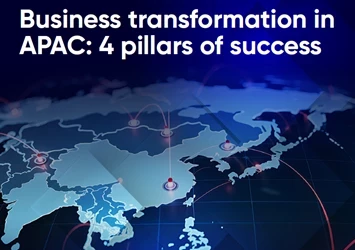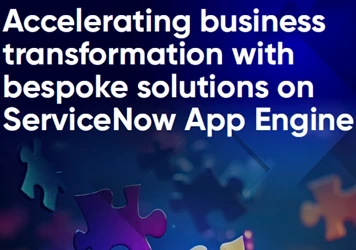Driving quality customer experiences in financial services
Discover the greatest challenges impacting customer attraction and retention in financial services, the solutions countering them and real-world examples of the solutions in action
Add bookmark
We respect your privacy, by clicking "View report" you agree to having your details passed onto the sponsor who may promote similar products and services related to your area of interest subject to their privacy policy. You have the right to object. In addition, you will receive our e-newsletter, including information on related online learning opportunities. For further information on how we process and monitor your personal data, and information about your privacy and opt-out rights, click here.
Introduction
Customer expectations in the financial services sector regarding efficient, digital solutions are higher than ever. This is in large part due to the Covid-19 pandemic bringing a number of new challenges, such as managing remote workforces and implementing new tools that look as though they are here to stay.
There is a vast amount of competition in the financial services field that sees start-ups and long-established organizations contend for customers. To remain competitive and avoid customer churn, these organizations need to meet and exceed increasing expectations.
Solutions such as robotic process automation (RPA), smart banking powered by artificial intelligence (AI) and central, automated data management and analytics are already being applied in the financial space.
Organizations that can bring these solutions together to deliver holistic customer experiences will put themselves in good stead in the coming years. This is particularly true if a focus on innovation can be integrated into company culture and embedded as a system of continuous improvement.
This PEX Network report highlights the challenge of meeting customer expectations and the solutions and technologies being applied in the financial services space to deliver quality customer experience (CX). Featuring real-world examples from Standard Chartered Bank, MSU Federal Credit Union, Extraco Banks and Red River Bank, it looks at how these solutions are attracting and retaining customers and improving business results.

Addressing customer demands for online services
The Covid-19 pandemic shifted the landscape for many financial customers and changed the demands they make of the financial organizations they deal with. According to Forbes, the pandemic and the ensuing disruption it caused has resulted in drastic and permanent changes to the way we live and, in many cases, how we wish to manage our finances and interact with banks and financial institutions.
The most obvious change has been the shift to remote working, which forced many of us to employ digital channels for financial management, as doing so in-branch was no longer an option.
The pandemic put many customers in a heightened state of confusion or distress regarding their finances, particularly if they lost their job and were forced to rely on government assistance. This left customers seeking more seamless online services from banks and financial institutions to ease the stress of financial management.
The need to remove overcomplicated processes is a trend that has stuck ever since, as Vinod Srinivasa, operational excellence professional at a US-based multinational bank, explains.
“Customers are looking for digital convenience for most of their day-to-day financial transactions and are expecting their complex and critical scenarios to be handled seamlessly,” says Srinivasa. “Banks need to carefully plan their multichannel presence so that business infrastructure keeps customer and product data synchronized across channels. This would provide a seamless, connected experience to the customer.”
Related content: Three trends shaping the financial services industry
There is also a need for customer experiences to be speedy and efficient as well, in a world, Srinivasa notes, “where we expect instant gratification [with anything less making] a bad experience”.
“Firms need to devise processes to capture the needs and expectations of their customers, bake those into their strategy formulations, deploy timely solutions, gather the crucial customer feedback on a dynamic basis and refine the customer-centric processes,” he adds.
Implementing seamless, digital customer experiences will allow established banks to stay competitive and avoid falling behind newer, digital-first banks, also known as challenger banks or neobanks. According to Srinivasa, the offerings they provide are difficult for customers to resist.
“[Neobanks offer] innovative products and superior customer service that satiates the tech-savvy generation, [this is key] as the smart phone penetration rate is on an exponential upward curve,” Srinivasa explains.
The next section of this report looks into some of the solutions being deployed in the financial space in response to shifting customer demands.

The solutions driving quality customer experience in financial services
Recent years have seen a number of innovations that drive quality CX in the financial services sector. These include a drive toward paperless, digital processes and the rise of automation technologies, all of which have been geared toward enhancing process efficiency and keeping customers happy.
Related content: How to achieve agility in financial services
Here we will dive into some recommendations from financial services experts for the optimization of customer experiences and how they can transform the way customers view a business.
Creating partnership with fintechs
Traditional banks are experiencing a new wave of competition from new, innovative fintechs and digital-first neobanks that are offering services many customers never knew they needed. They have implemented newer technologies to give customers more choice with how they manage their finances than ever before.
Chime or Monzo for example, employ AI to transform CX. Through automated, AI-powered analytics, these businesses can offer customers personalized banking experiences with features like risk notifications to alert them if a purchase might lead to a shortage of funds at the end of the month or investment features that offer smarter ways to save money.
With so much choice emerging in the personalized solutions available for financial management, it is unsurprising that the McKinsey Next in Personalization 2021 report found that more than 65 percent of surveyed financial customers rate targeted promotions and personalized messaging as important, very important or extremely important.
According to Benjamin Maxim, vice-president of digital strategy and innovation at MSU Federal Credit Union, the most effective way to compete with the plethora of innovative financial services is not to try to match all services that are being provided. His recommendation is to form partnerships with innovative financial service providers and leverage the work that has already been done to deliver quality customer experiences.
Related content: How global organizations are boosting customer experience with intelligent automation
MSU Federal Credit Union has been looking at how to take advantage of emerging technologies for process improvement with the view to better support their members. Maxim remarks: “We have now formed a credit union service organization to partner with fintechs, make new investments and continue to explore the industry [for new ways to help our members].”
Digital capabilities, including those achieved through partnership with fintechs, are key to convenient customer experiences, explains Srinivasa.
“Industry-leading digital capabilities that provide convenience and cyber-secure experiences to customers [are driving quality customer experiences in financial services],” he says. “With digital being the game plan, sales through digital channels will emerge as the highest contributor to revenue and will only increase going forward.”
Making the process of innovation continuous and scalable
The pace of innovation in financial services shows no sign of slowing so if a financial institution is not actively and continuously seeking to make life easier for its customers, there should be no surprise if it loses customers to those who are. Assessing how the business can partner with fintechs, integrate new technologies or innovate in attempts to improve CX should not, however, be an isolated initiative.
Focusing on a particular issue and implementing a solution to counter is a good start, but businesses need to consider how this can be done continuously and at scale.
Rajdeep Sadhukhan, executive director, operational excellence at Standard Chartered Bank, explains: “It is one thing to swarm around a particular area, get the leaders aligned, take a deep-dive into the details and drive change, but doing this consistently and at scale is really tough.
You can get completely different outcomes [for process initiatives] under the exact same conditions.”
At PEX Live: OPEX APAC 2021, Sadhukhan discussed the methods applied at Standard Chartered Bank to make innovation and optimization a continuous process. One was integrating transparency into the process by sharing data analytics globally.
Related content: Scale up process improvement through automation
The bank wanted to be able to automatically share information on a project conducted in one branch of the business to the rest of the organization.
To accomplish this, a central data repository, named the A3 Portal, was implemented. It aggregates, analyzes and shares data across the global organization providing the necessary metrics to assess the state of transformation in the business.
“If we are able to measure the progress of transformation, it automatically expedites the process,” noted Sadhukhan. “The A3 portal has become the center of our transformation as once we make improvements visible [across the business], we can implement leader boards, gamify the transformation process and start to get more employees involved.”
The next section of this report offers real-world examples of financial services organizations optimizing CX processes and the results they are achieving.

Real-world financial services organizations optimizing CX
This section provides two examples of how CX is being optimized on the frontlines in the financial services space and the results that have been achieved through real-world initiatives at banks and financial institutions.
Extraco Banks applies technology to keep up with the pace of innovation
As mentioned earlier in the report, banks and financial institutions find themselves at a point where they must drive innovation in the way they deliver experiences to customers or risk losing them.
Extraco Banks came to this very realization when the pandemic was at its peak and sought to implement new technologies in order to keep up with the competitors applying cutting-edge solutions that included AI or process automation.
One of the most time-consuming, manual tasks that the bank was operating with was the approval of remote deposit capture (RDC) requests. A decision was made to implement RPA to allow this process to be completed automatically, without human involvement.
Extraco Banks implemented Nintex’s RPA solution, which was put together within 12 hours. The result was an automated process for RDC approvals that saved the business 1,200 hours per year and halved the time taken to complete them.
The effect of this was increased efficiency and an improved experience for Extraco Banks’ customers at the height of the pandemic. Despite the closure of many branches the bank was able to continue approving RDC requests and to do so at an unprecedented rate.
Regarding the initiative Cal Stevens, vice-president and business process improvement manager at Extraco Banks, says: “Using RPA for our RDC approvals helps us better serve our customers faster and when they need us. The solution will save our call center staff time that they can use to focus on higher-value tasks that better support our business and customers’ needs.”
Red River Bank automates Covid relief for customers
The disruption felt by financial customers as a result of the Covid-19 pandemic, discussed earlier in this report, resulted in legislative changes. The Small Business Association rolled out the Paycheck Protection Program (PPP) in the US as part of the Covid-19 aid, relief and economic security (CARES) act. This enabled relief funds for those who found themselves in a position of financial hardship as a result of the pandemic.
When the PPP was announced, Red River Bank realized it would need to take quick action to ensure these relief funds were available for those who needed them. As Red River Bank had grown prior to the onset of the pandemic, however, the need for integrated solutions that blended people and technology together became clear.
Red River Bank was informed that it would not be possible to implement the necessary solutions until at least one week after the government finalized PPP requirements. This meant leaving customers without critical funds during a time when they were much needed.
This was not quick enough for Red River Bank, who implemented the Nintex Process Platform. The business was able to develop and implement an automated PPP application solution that was pushed live the day after the platform’s implementation.
The solution applied automation to simplify and expedite the loan process, putting critical funds into the hands of customers as quickly as possible. Overall, the automated solution went from idea to implementation within 36 hours, which was a huge win for the business as they were able to meet a critical demand and keep customers happy.
Final remarks
There has never been a more important time for financial institutions to focus on how they can best serve their customers in order to retain them and win new ones. With the pace of innovation in financial services rapidly accelerating, customers have more choice than ever with regard to how they manage their finances and interact with banks.
Financial services organizations need to be aware of this and take steps to optimize and overhaul processes to deliver a better overall CX. Methods for achieving this include partnerships with innovative fintechs to deliver cutting-edge solutions and improved data management to enable transparency and expedite transformation.
Financial customers today are well aware of what services are available in the market and will consider switching to online banks if traditional financial institutions do not offer similar solutions. Financial institutions that fail to put their customers first and take steps to improve their experience.

This report was originally published on 04 April, 2022 and was updated on 10 October, 2022


































































































